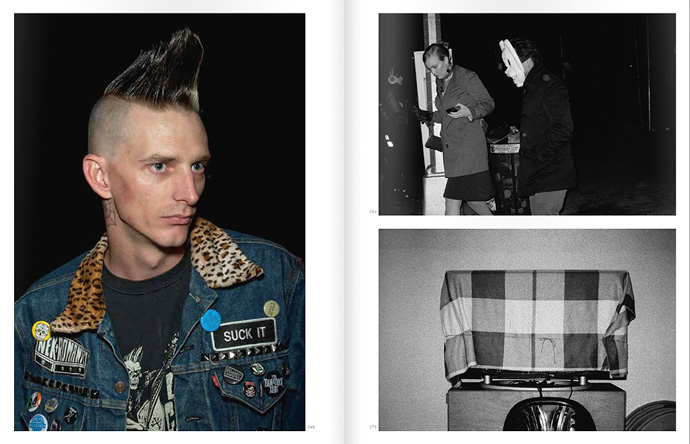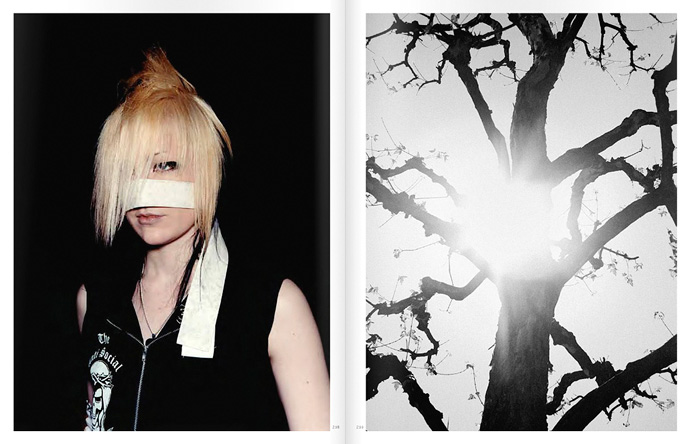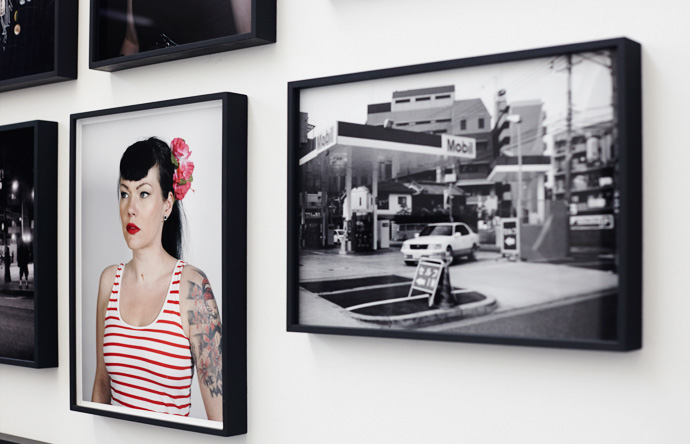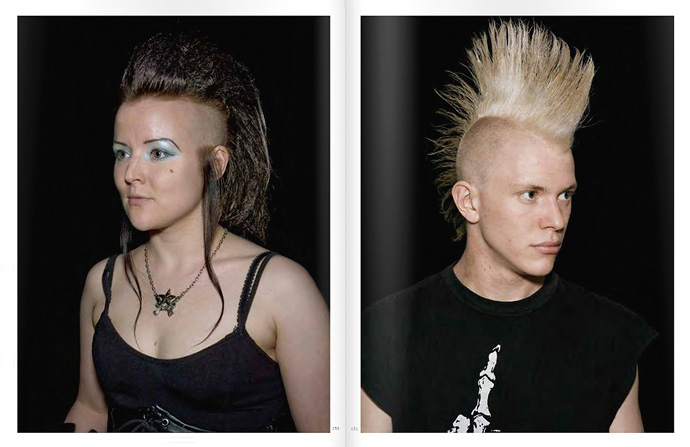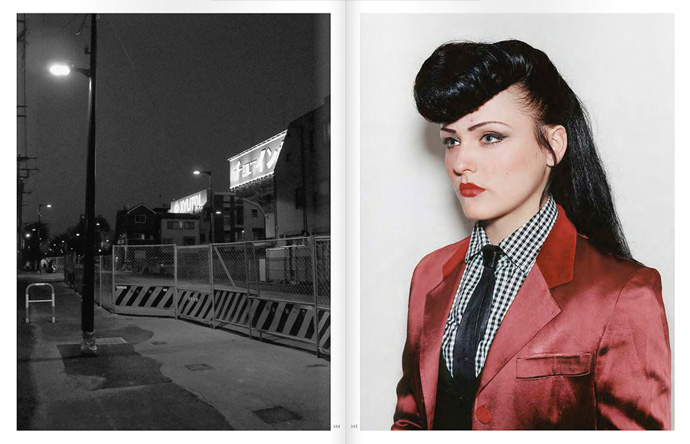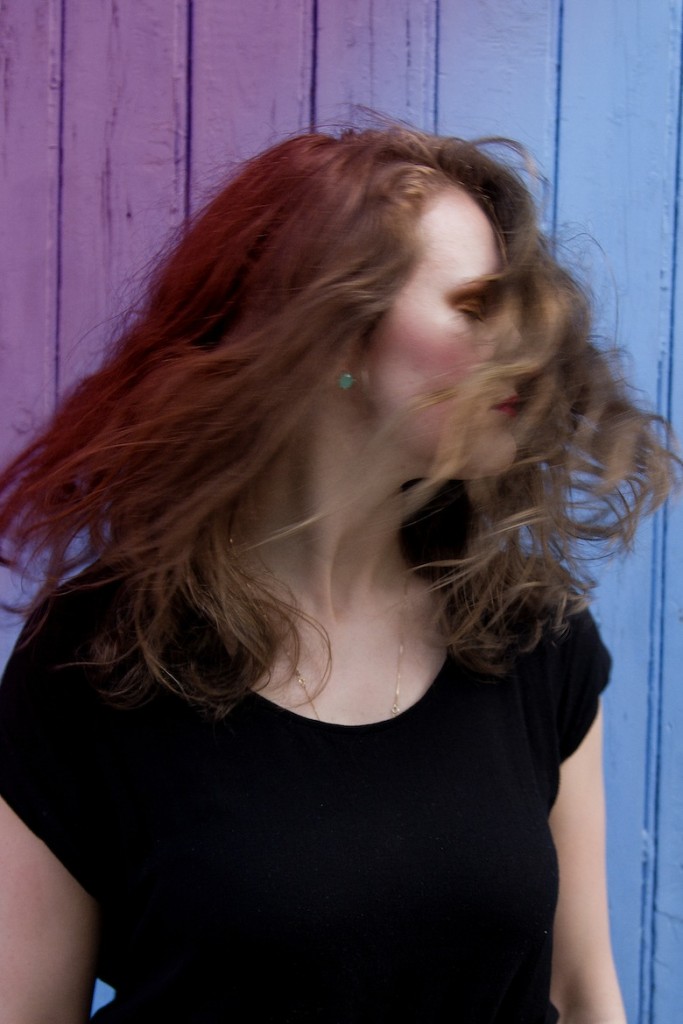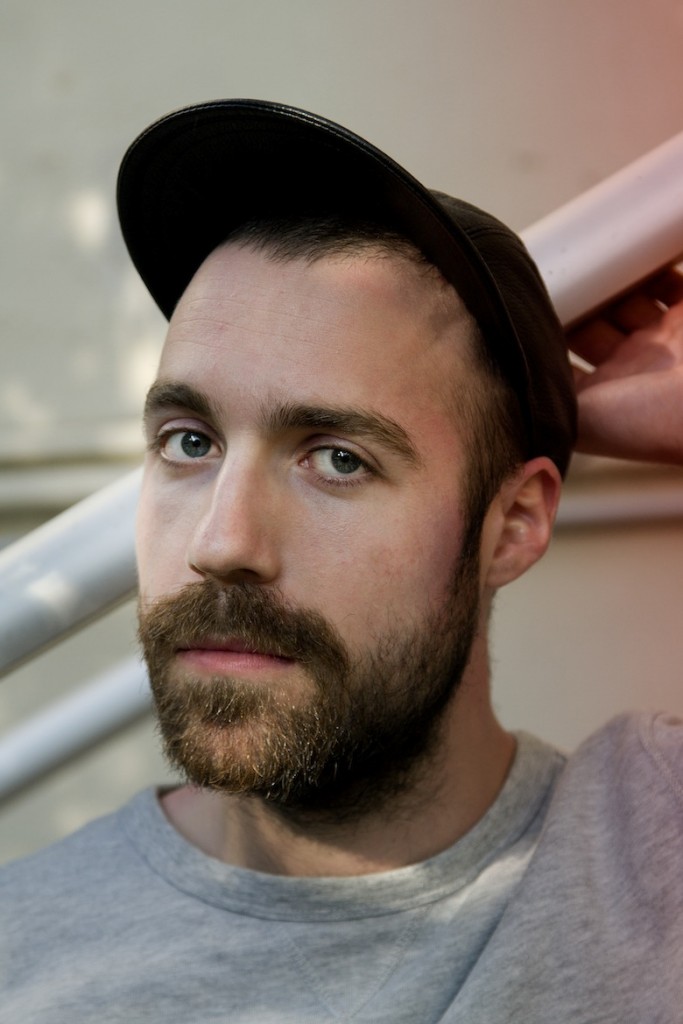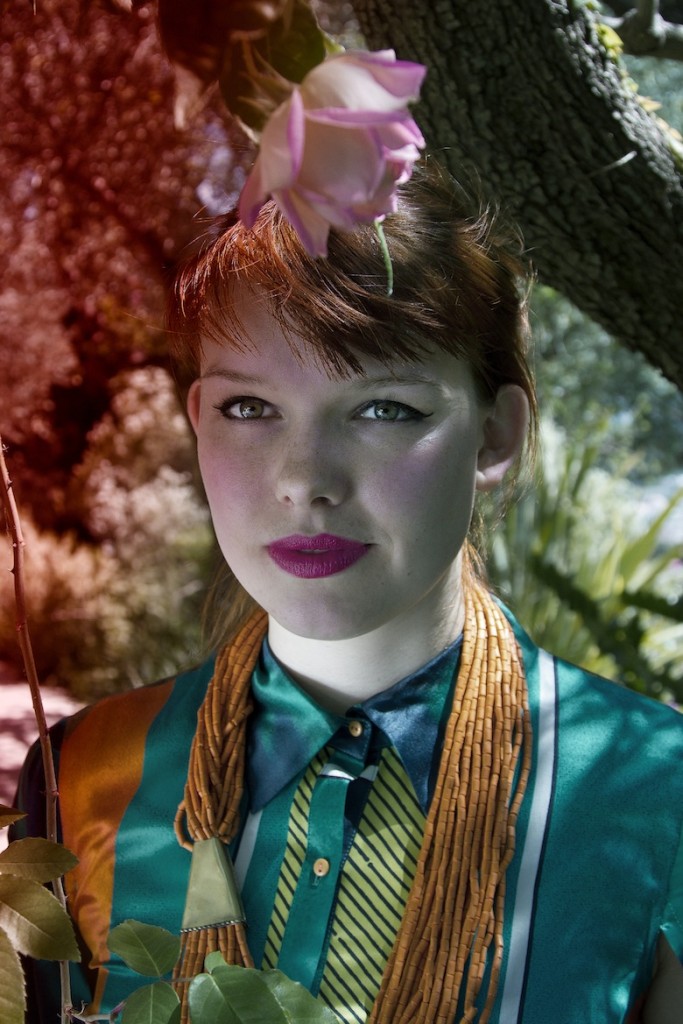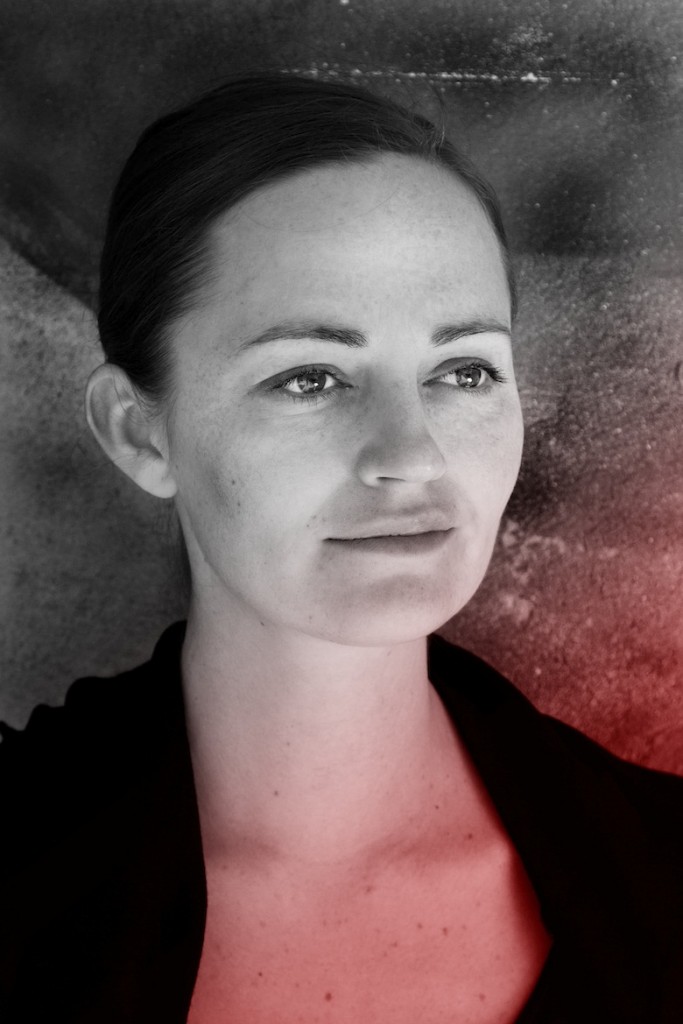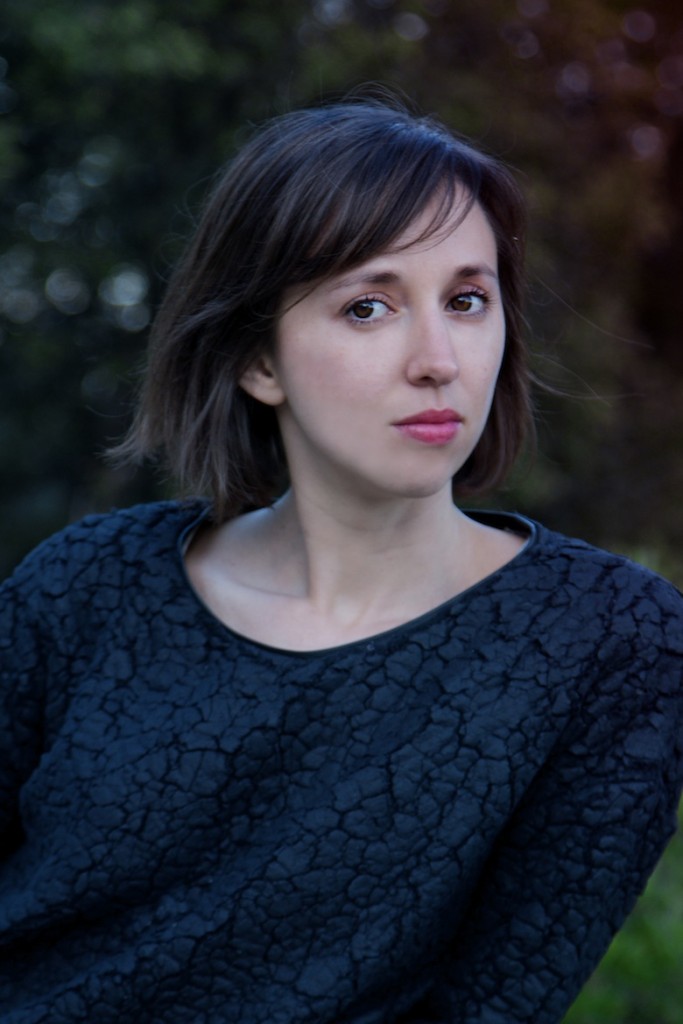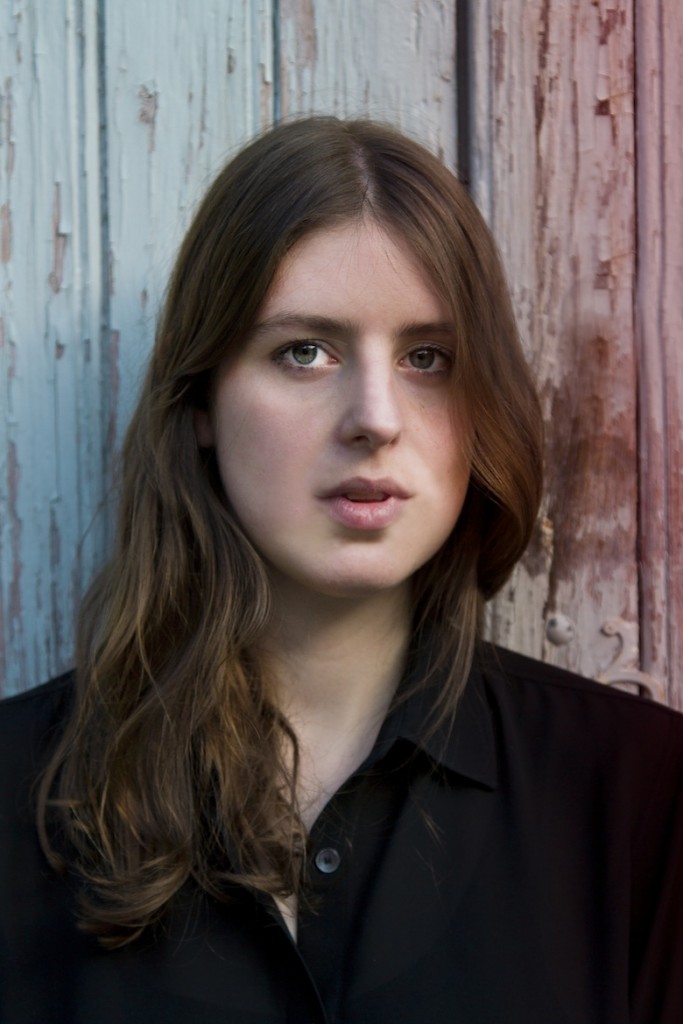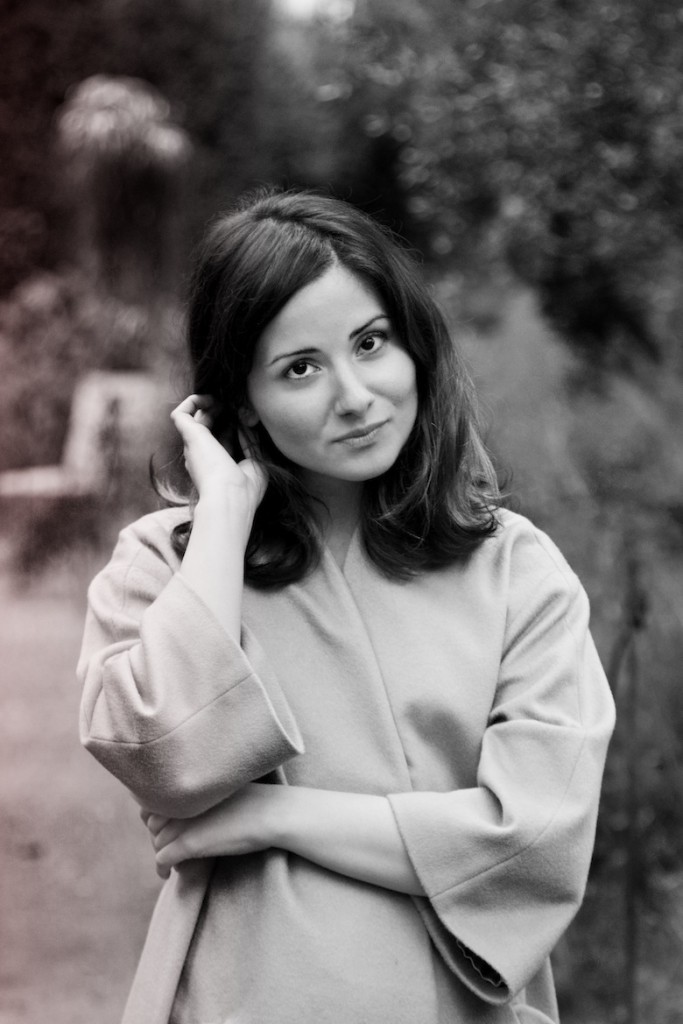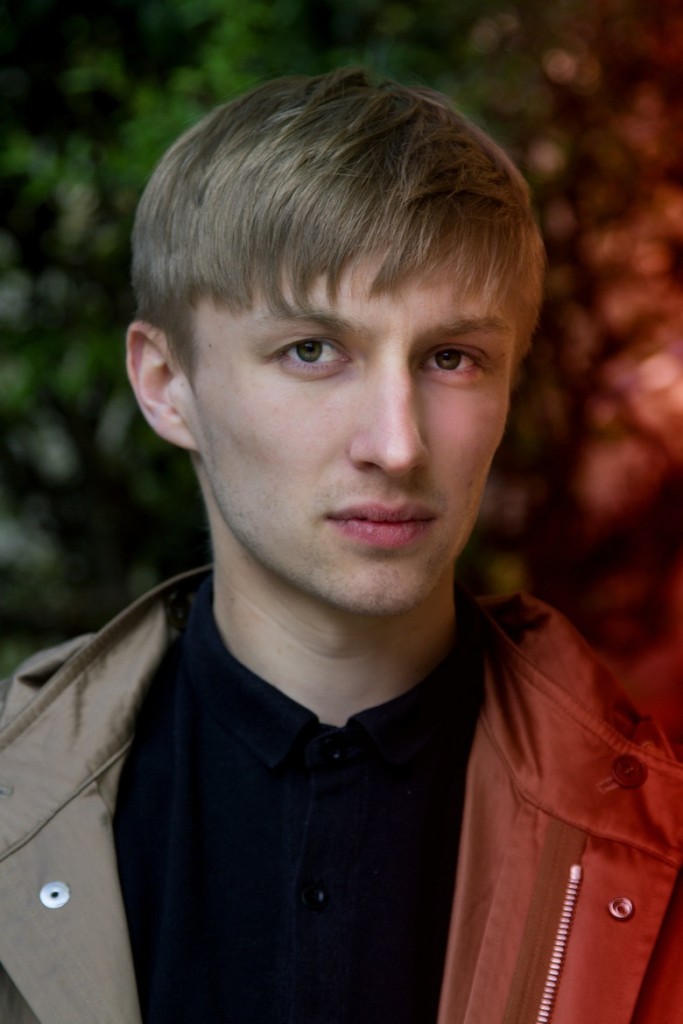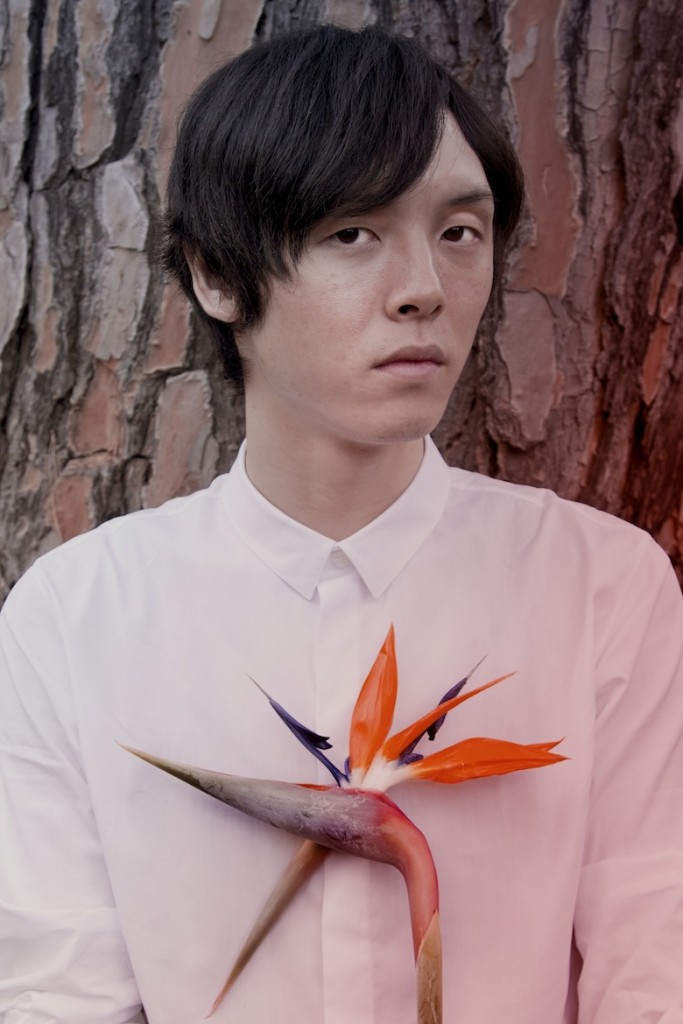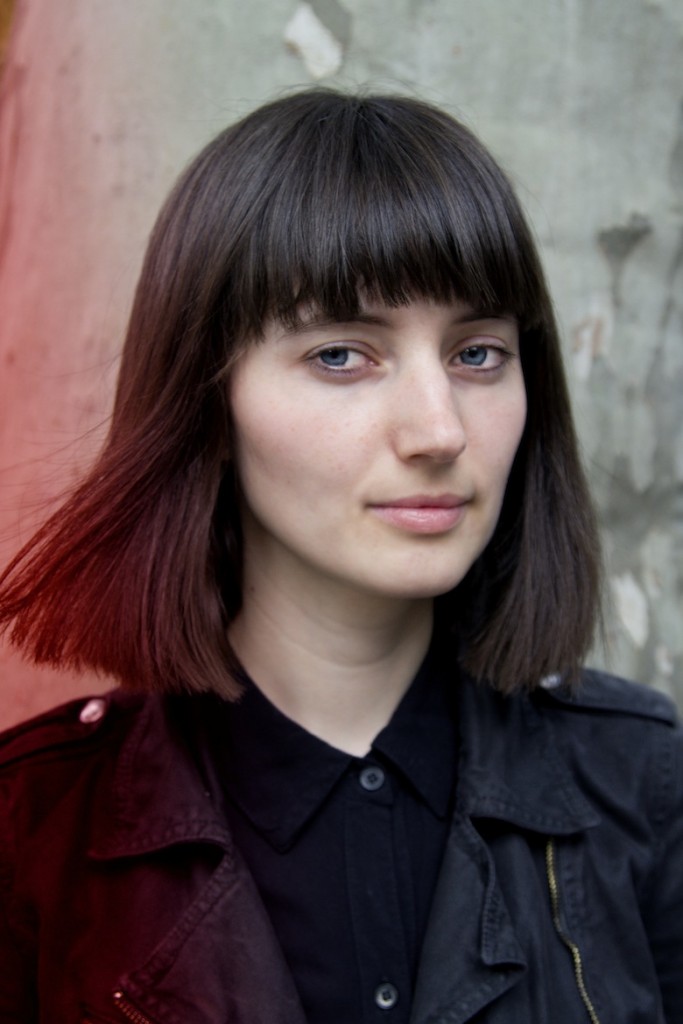-

OLIVER SIEBER – “THE NEW FUCK YOU”
-America, Asia, Europe… each continent spawns its own counter-cultures, centered for the most around music scenes. From these subcultures, Oliver Sieber creates an “Imaginary Club” composed of goths, punks, skins and rockabillies – irrespective of their cultural demarcations.
About 100 photos define the perimeters of Oliver Sieber’s “Imaginary Club, portraits taken in a makeshift studio of concerts, festivals and in clubs, and juxtaposed with black and white shots of deserted rehearsal spaces, street shots and club entrances.
Oliver Sieber’s “Imaginary Club” is exhibited at the Villa Noailles in Hyères as part of the 29th International Fashion & Photography Festival, a variation on his most recent book of same title. While setting up this exhibition, Oliver and his collaborator Katja Stuke spoke to The Stimuleye about the need of upheaval, total erosion of style and dress codes in youth culture and the need to find new forms of expressing positions of identity.
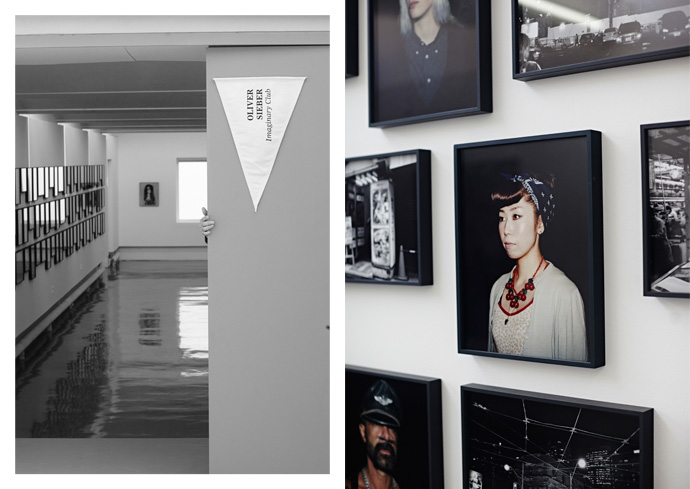
Oliver Sieber, "Imaginary Club": Exhibition at Villa Noailles, Hyeres
THE IMAGINARY CLUB
The Stimuleye: Who are these people in your “Imaginary Club”?
Oliver: What really interests me is reaction and forms of counter culture.
After WWII, the teenagers in America and England started to discover new forms of music and fashion, new forms of liberation. Many people I met are still in this sort of idea. Punk is a very good example, because it did have real societal meaning.That is what is important to teenager culture: upheaval, the struggle to identification, to root themselves. To not only take position against the elder generation, but in general. And that has often to do with music. I am interested in music, and communication of style codes.
The people in my “Imaginary Club” are not always part of a subculture in the classic sense. I have also portrayed artist friends, that, similar to teenagers, are forced to redefine themselves again and again. Here for example is a photo of Rebecca. From a wealthy family, she received always best grades, suddenly something switched in her head. Rebelling against her intellectual parents, she was climbing down the eaves gutters and was not to tame anymore.
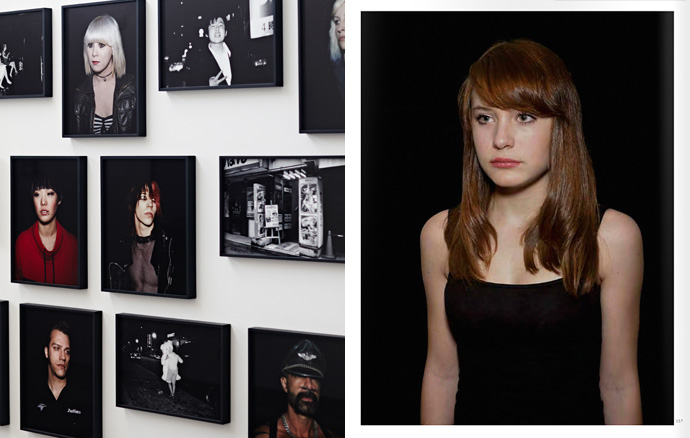
Oliver Sieber, "Imaginary Club": Exhibition at Villa Noailles, Hyeres. Right Side: Rebecca
When I look at my work, I understand it as an entry for the viewer, or a window upon which I reflect myself. Often it is not really about what is on the wall or who is depicted, but about the dialogue between the image and the onlooker. That changes from person to person.
The Stimuleye: Looking at the Portraits there are many Punks, Skinheads, Rockabillies.- is there also something a bit like nostalgia?
Oliver: We have a very globalized music culture today. Subcultures developing real novelties is something rather sparse and rare. Are there really subcultures that result from youth movements? I think it is not like that anymore. It’s more that youngsters try to identify with their role models of choice.
A good example is David Bowie that in the 70’s offered an image of “multi sexual liberation” for many people, also in combination with music and the song texts that bore a poetry and language that people picked up on. Just because we have 2014 now, his music did not disappear. You can still buy the records and the language still speaks to people who want to identify with it. And as fans do, they associate themselves with this. I think people living this don’t reflect on what they do, as we look at it. They just do it.
Katja:
There are always new aspects adding up and things get mixed up. So you have a development that can’t be called the “nostalgic”. It may be rooted in a source, and like in this case ideally there is a progression where new aspects ad up.Oliver Sieber, excepts from the book "Imaginary Club"
FASHION CODES AND THE INTERNET : THE NEW “FUCK YOU”
Katja:
Today you often cannot rely on the looks giving an indication on who people are: In Germany you find nazis that look like left anarchist “Antifa” fighters.
That possibly has to do with the internet, where you can communicate your stance or orientation in different ways then through fashion and dress codes.
You also have to react on other people adapting what you personally take serious as a subculture, how they mix your codes, abuse or pervert them.This makes it sometimes also difficult to determine whom are you following in a protest, where codes are so mixed up, that no one is able to keep up track.
For example in Ukraine its absolutely ambiguous who is protesting with whom recently. Unlike in the past, today it’s hard to determine who is on which side, from demonstrator to counter protester. Now you have young Nazi Hipsters in all black with tight jeans shouldering a jute bag, which really requires more than a second look to recognize what is going on.In this position you’re forced to find other forms to show your conviction that are different and function without the need of fashion as we had it in the past.
I am sure there are subcultures, but they function really differently, without the involvement of fashion, as the channels are much more multi layered. It’s not about provoking through your look anymore, because nowadays people are not easy to shock. So you have to find other ways and places to put your orientation forwards.Oliver Sieber, excepts from the book "Imaginary Club"
Oliver: In Japan a lot of messages get transported through flyers and stickers. This was similar in Los Angeles up until recently, but it changed and is now functioning mainly through hotmail panels. Everyone has a smartphone, no matter to which group you belong. The Cosplay culture for example functions only through the forums in the web. That’s all chat, appointments for conventions and Skype.
Katja:
But the internet is not at all as public as you may expect.
Often it’s very difficult to access a certain online group or forums. There are strict admins that want to know who you are and what you do, and remind you that with access you commit to a regular contribution etc- so you can’t just get in and check out. It’s much easier to go into a bar or a club, even if you have to pass and convince the bouncer.Oliver:
For example I photographed a young punk who realized how his style had been adapted and declared a trend. He totally changed his appearance to not be associated with this widely publicized new trend. That doesn’t mean though that his anti-ascist conviction or adoration for punk changed at all.As label and the designers pick up on elements of subculture their message is watered down extremely fast, so you have to have to change your codes again. As Jason (Evans) recently said at the Tate: “The new normal is the new ‘Fuck You,'”, because you can’t be categorized like this anymore.
Oliver Sieber, "Imaginary Club": Exhibition at Villa Noailles, Hyeres
PROTEST
Oliver:
That there is a new protest culture again is really great. These positions are getting from the internet to the street again, where you suddenly have to make an effort, as the codes we’re used to don’t work anymore when you can’t diversify between “good” and “evil”, nor recognize “your” or “my” people.Katja:
At the same time there is also these movements of parallel culture to create an existence and surrounding of some sorts of withdraw, even resigning.
This may be an approach resulting from being overwhelmed by societal developments. Specially in Japan we’ve met people that engage in small initiatives, artistic ones or others that take care of the homeless. There is this movement of “do it yourself” culture where people search for new forms of living for themselves apart from mainstream, norms and social graces, which are less visible.Oliver:
When visiting Osaka soon for another exhibit, we plan to investigate deeper into this, meet with these “alternative” people that found a totally different life and structure within of Japanese society.
What I found puzzling was that we met many homeless who spoke great English or Spanish, and had lived and worked abroad, but this had lead that they were not fully integrable any more into society, because the’ve been abroad too long and back in Japan landed on the street.Katja:
I think that also has to do that people with knowledge of languages have access to much more information over the internet for example, and thus are more open to ideas to try a different draft for their life than their parents, because that didn’t work that well either.
Specially as you can’t rely on social securities anymore- it’s not like our parent generation that studied, took a job and continued with a great retirement plan.Oliver Sieber, excepts from the book "Imaginary Club"
The Stimuleye: How do you work together?
Katja:
There are varying methods, but at times there are actual connections or a common greater theme and possibilities to juxtapose our work in an exhibition or we publish a book together for example at BöhmKobayashi.The City of Duesseldorf has provided us with a space we curated for three years where we developed “ANT!FOTO” which was to show exhibitions on positions of photography we feel were missing. As a result we also started a publication the “ANT!FOTO Manifest” which was a common project of us.
Oliver:
The “ANT!FOTO Manifest” was a project where we asked 70 photographer and curators to word their statement after a 10 point thesis we created. Initially this was planned only as a magazine, but finally will be shown in the Museum Folkwang as well as going to the
Fotomuseum Winterthur .The Stimuleye: What is the last thing that stimulated you?
Oliver:
After we talked so much on imagery, I would like to mention something that stimulated me:
when we talked to Frenkie (Bosnian Rapper) while visiting him in Tuzla, i asked him what is “heimat” (homeland) to him.
He said after being a refugee returning from Nuernberg to Tuzla, he realized what he missed: it was the scent of the firing wood that you can smell everywhere in the city. For my senses, apart from sound or music, the smell is very important.Oliver Sieber, excepts from the book "Imaginary Club"
Imaginary Club 2005-2012 432 pages, Offset-Print, a BöhmKobayashi/GwinZegal Joint
Imaginary Club is running at the Villa Noailles in Hyeres until may 25, 2014 and after that at the Galerie Stieglitz 19 in Antwerpen. Opening May 25, 2014, further dates are at PhotoBookMuseum from August 19, 2014 and after that the Exhibition will be travelling
10 -

#AllEyesOnHyeres2014: Meet the 10 Competing Designers
-In preparation for their meeting with the Design Jury, the 10 Competing Designers hurried around making last-minute adjustments and consulting with stylists, while The Stimuleye spent some time getting to know each candidate.
Herewith, a selection of video, photography, and text that offer brief introductions to each of these talented young designers.
All Photos by Filep Motwary
Marit Ilison
Who are you? Your age, your origin, your background, type of collection?
My name is Marit Ilison, I’m 29 years old and live and work in Tallinn, Estonia. I have a diploma in pattern making and I studied one year as an exchange student at Danish Design School before receiving my MA degree in Fashion Design from the Estonian Academy of Arts in 2008. Since then I have been working as a freelance artist and designer, creating in the fields of conceptual art, fashion, costume design, site-specific installations, perceptional experiences and exhibition design. I also teach and play drums in a psychedelic band.How would you describe Hyères in three words?
Palms, unreal, friendly.What has been your favorite part of the process so far?
Meeting like-minded people and collaborating with small local artisans in Tallinn. It is so wonderful how so many people have believed in my work and helped me to execute it.What is your collection about? Please explain your inspiration and starting point, and how it has evolved in the process.
Regardless of the discipline, my main goal is always to create memorable experiences and I always start from a feeling I want to create or an idea I want to express. Longing for Sleep is inspired by my haunting wish to sleep during the dark wintery time called kaamos. Kaamos is a word only know in Estonian and Finnish and it’s referring to the time from November to January when the days are very short and it barely gets light. On one side I would only like to stay in bed and daydream at that time, but on the other side I feel conscience pricking me, which reminds that I should actually be working instead of sleeping. To materialize the feeling I’ve created a collection using original vintage Soviet woolen blankets.In what ways you think participating in a Festival like Hyeres will help you in the future?
It is a truly unique chance to present my work to wider audience and get the spotlight on it. I am looking forward to meet like-minded people and find exciting future collaborations in fashion design, site-specific installations and experiences.Louis Gabriel Nouchi
Who are you? Your age, your origin, your background, type of collection?
My name is Louis Gabriel Nouchi. Im french, I’m 26 years old. I live in Brussels. I’m studying at La Cambre.How would you describe Hyères in three words?
Intense, exciting, sunny.What has been your favorite part of the process so far?
To see my clothes worn by a real model.What is your collection about? Please explain your inspiration and starting point, and how it has evolved in the process.
I’ve made a collection about the movie Princess Mononoke from Hayao Miyasaki and the notion of balance between opposite forces that have to live together in harmony.In what ways you think participating in a Festival like Hyeres will help you in the future?
I hope it will help me to meet professionals and create contacts for whatever is going to happen after school.Liselore Frowjin
Who are you? Your age, your origin, your background, type of collection?
My name is Liselore Frowijn, I am 22 years old and I come from the Netherlands. I graduated Cum Laude less then a year ago at ArtEZ Institute of the Arts in Arnhem, the Netherlands, on my bachelor fashion design. I designed a collection womenswear which is about the contrast between sportswear and luxury with the use of self designed fabrics.How would you describe Hyeres in three words?
I would describe Hyères as exciting, energetic, and a creative meltingpot.What has been your favorite part of the process so far?
Regarding to the festival I think my favorite part of the process so far is to meet all the other designers and creatives, being together in the villa and working hard to create a beautiful festival.What is your collection about? Your inspiration and starting point and how it has evolved in the process.
My collection ‘’Afternoon Of A Replicant’’ is about the clash between sportswear and luxury, which is based on the cut-outs of Matisse. By cutting and pasting with paper, I created cut out-suits for women of my time. Above these suits are pieces of artisanal fabrics with self-designed prints, hand-painted or embroidered. The silhouettes are voluminous and layered. The transparency of fabrics causes an eclectic play-a-long between background and foreground: a fresh kind of luxury is the result.In what ways you think participating in a Festival like Hyeres will help you in the future?
I hope that Hyeres will bring me the right connections to help my career a level up in the fashion industry. I would like to work as a fashion designer womenswear in a house in for example Milan or Paris to gain more experience. Later on, I would like to have my own brand. By being part of this Festival all ten finalist are really put on the radar, a lot of people will notify our work, which can be very helpful.Agnese Narnicka
Who are you? Your age, your origin, your background, type of collection?
My name is Agnese Narnicka, I am from Latvia, Riga city. I received an M.A. from the Art Academy of Latvia in 2009. I have enriched my knowledge and experience in Accademia di Belle Arti di Brera, Italy, Milano. After graduating I started to work on my own label One Wolf. I will present menswear collection “Repair man.” Collection has urban shapes and multi layered look.How would you describe Hyeres in three words?
Bloom, Team, FutureWhat has been your favorite part of the process so far?
My speech rehearsal :}What is your collection about? Your inspiration and starting point and how it has evolved in the procedure.
The Inspiration for collection “Repair man” comes from my personal experience in 2012 when I was doing repair-works in my apartment. During this period I met several craftsmen whose personalities influenced the making of collection and are reflected in its characters. By taking off the old paint, by coating walls, painting, grinding and applying tiles I discovered many textures, colours and combinations of different materials.In what ways you think participating in a Festival like Hyeres will help you in the future?
The Hyères festival provides an opportunity to show my creations to a wider audience and to get new contacts. I really appreciate this opportunity!Coralie Marabelle
Who are you? Your age, your origin, your background, type of collection?
My name is Coralie Marabelle, I am French and I am from Paris. I am presenting a womenswear collection for the Hyères Festival.How would you describe Hyeres in three words?
Exciting, surprising, promising.What has been your favorite part of the process so far?
So far i have really enjoy discovering the Villa Noailles. It’s an amazing place full of history. I feel super excited to work in this place where so many amazing artists have come before.What is your collection about? Your inspiration and starting point and how it has evolved in the process.
My collection is inspired from a picture of persian sheep shearers in 1952. Inspired by a very masculine outfit, I dreamt of a very feminine woman.In what ways you think participating in a Festival like Hyères will help you in the future?
I think the Hyères festival gives us a lot of visibility which is amazing. It also give us the opportunity to meet a lot of people from the fashion industry.Anne Kluytenaar
Who are you? Your age, your origin, your background, type of collection?
My name is Anne Kluytenaar, I am 27 years old and I am from the Netherlands. My collection is menswear.How would you describe Hyères in three words?
Inspiring, exceptional, fun!What has been your favorite part of the process so far?
My favourite part so far was making the fabrics and creating embroidery.What is your collection about? Please explain your inspiration and starting point, and how it has evolved in the process.
I was inspired for my concept when my father told me one evening that he would continue to live life as a woman. She was not aware of the physical difference between women and men and would wear all the volume on the shoulders and wear a slim pencil skirt with it which augmented her masculine shape. To me the house of Chanel is a perfect example of luxurious elegance with a clear silhouette. Also their rich fabric and details were very inspiring.In what ways you think participating in a Festival like Hyeres will help you in the future?
It has opened me up to broader possibilities in the international fashion scene, allowing me to showcase my work to a wide audience and connect with industry professionals as well as like minded designers.Roshi Porkar
Who are you? Your age, your origin, your background, type of collection?
Roshi Porkar, 25, Vienna, women’s wear.What is your collection about? Please explain your inspiration and starting point, and how it has evolved in the process.
Feminine, fancy. fancy. The theme of the collection is based on a series of little statutes of stone, known as the Bactrian Princesses. I worked around the woman’s body, exaggerating the conventionally desired form for a woman’s body.
How would you describe Hyères in three words?
Exciting, emotional, exhausting.What has been your favorite part of the process so far?
Getting to know all the talented contestants and the jury members.In what ways you think participating in a Festival like Hyeres will help you in the future?
I just hope to be busy for the next few years.Pablo Henrard
Who are you? Your age, your origin, your background, type of collection?
My name is Pablo Henrad, I’m belgian and I just finished studying at La Cambre. I am presenting a menswear collection called Maelstrom.How would you describe Hyeres in three words?
Exciting, exhausting, and crazy.What has been your favorite part of the process so far?
To meet and to get to know all the contestants.What is your collection about? Your inspiration and starting point and how it has evolved in the process.
I worked on the darkness and the mystery of the untouched oceanic abyss. I questioned the notion of elegance, sensuality and sophistication in the masculine wardrobe.In what ways you think participating in a Festival like Hyères will help you in the future?
It surely helps because of all the interesting people we met here, the new connections and all the professionals.Kenta Matsushige
Who are you? Your age, your origin, your background, type of collection?
My name is Kenta Matsushige, I’m 25 years old, I’m from Yamaguchi in Japan. I studied fashion 2 years in Osaka and 2 years in Paris. Now I working as a freelance designer and modelist (pattern maker) in Paris. My collection is a womenswear collection.How would you describe Hyères in three words?
Nature, meeting people, collaborations.What has been your favorite part of the process so far?
All the process is really important for me, to create my own universe and work on volumes, fabrics, and find technical details or construction.What is your collection about? Your inspiration and starting point and how it has evolved in the process?
My collection was inspired by minimal structure, nature serenity, and traditional elements. I tried to find a balance between their confrontations.In what ways you think participating in a Festival like Hyères will help you in the future?
Hyeres gives me opportunities to collaborate with professionals and meet people who understand me and help me to create my universe. It will help me to create my own brand in the future.
Yulia Yefimtchuk

